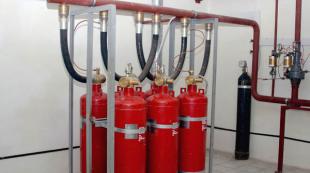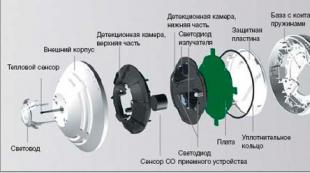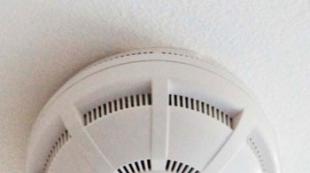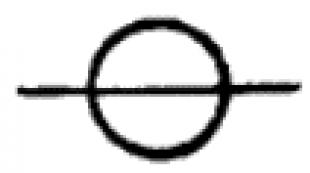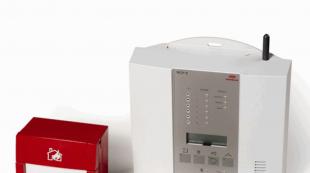Light temperature of LED lamps. What is the color temperature of LED, halogen and xenon lamps measured
One of the most important parameters of an LED lamp is the color temperature of the lamp, which for LED devices fluctuates over a fairly wide range. This term means the temperature at which a monochrome black body begins to emit a glow of a certain spectrum (corresponding in tone to the lighting that this lamp creates).
The lower the color temperature, the warmer the shade of its glow. For example, for a candle flame, this figure is 1500-2000 K, for an incandescent lamp - 2700 K, and for so-called cold daylight fixtures - 6000 K and higher. To choose a lighting device based on its color temperature, it is important to know information about it.
How does this indicator affect the perception of objects?
Modern manufacturers produce LED lamps with various indicators of color temperature. All of them create different lighting, the properties of which can be used for a specific purpose. Warm reddish yellow, pale golden or bluish-white glow affects the visual perception of space, as well as the emotional state that a person enters while in this room.
If you choose the right color temperature of the LED lamp, you can increase the visual attractiveness of the product and increase the willingness of customers to make a purchase. In museums, well-organized lighting emphasizes all shades of color and features of the texture of the exhibit, which also attracts visitors. In public places, white light of different color temperatures helps to create a suitable setting for morning, afternoon or evening time.
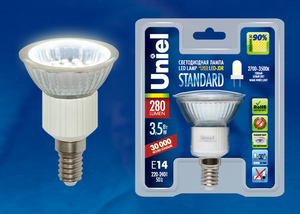
The choice should be made in accordance with the task that is set for the lighting system:
2700 K. Devices with such an indicator create a cozy, warm lighting. Recommended for installation in restaurants, salons, hotel lobbies, as well as residential premises.
3000 K. It is close to neutral white light with a slightly yellowish tint. Suitable for creating an intimate, friendly atmosphere in a room. Lamps with such a color temperature are mounted in offices, shops, libraries.
3500 K. Pure neutral light, in which the environment seems safe and comfortable for the person. Such lighting fixtures are also good for offices, they are often installed in exhibition halls, bookstores, and the lobby of movie theaters.
4100 K. This is a more invigorating cold light. It will be appropriate where it is required to provide a productive atmosphere, as well as a good color perception of objects. It is this color temperature that LED lamps often have in large supermarkets, medical centers, and training rooms.
5000-6000 K. If the lighting device produces a sharp white light close to daylight, then its color temperature is most likely in this range. Ophthalmologists do not recommend being under such lighting for a long time and warn against using this type of LED lamp in the evening or at night. But for medical examinations, in art galleries, museums and jewelry stores, cold daylight will be in place. It perfectly conveys all shades of colors, provides good visibility of objects and the environment.
Can an LED lamp give a glow of different temperatures?
Some manufacturers have launched the production of lighting structures that emit a glow of different color temperatures. Their device allows you to adjust the shade of light in accordance with a specific situation. This is very convenient and physiological, since a warmer yellow light will be natural for the morning hours, and during the day you can eliminate the lack of light coming from the windows by artificial illumination of a similar tone, if necessary for work, reading or creativity.
LED lamps are widely used not only as signal elements or interior decoration, but also as lighting devices. They are the most energy efficient light sources to date.
Such lamps have broader characteristics than traditional lighting devices. Thanks to energy-saving technologies, LED lights significantly save energy in the room. So, an LED lamp with a power of 10 W is comparable to a conventional incandescent lamp with a power of 75 W and has a much longer period of operation.
LED devices environmentally friendly, they do not contain harmful substances in the form of mercury or lead. Unlike luminescent, metal-halide and gas-discharge types of lamps, they do not form fluctuations in the light flux and harmful radiation, which negatively affect the human eye.
Their main disadvantage is the rather high price. However, over time, such lamps can pay off, since the life of a quality lamp from well-known companies reaches up to three years. In addition, manufacturers are constantly modifying their products and in the near future its cost will be reduced by 20-30%.
Main characteristics
The basis of the lamp are several LEDs consisting of a semiconductor crystal. With the passage of current through the crystal, a glow occurs. Number of LEDs can be from one to several dozen, depending on the design and power of the lamp.
LED lamps are mainly divided by the following technical characteristics:
- by cap type
- device power
- glow temperature
- operating voltage (12 W to 220 W)
When purchasing lighting equipment, it is necessary to pay attention to the type of socle that must match the lamp.
Consider and light direction device. For wall or table lamps, a narrowly directed luminous flux is suitable, while a lamp with a uniform distribution of light is needed in the chandelier.
When choosing, you need to be guided by such factors as the power source and the number of LEDs. A large number of LEDs indicates that they do not have significant power, as well as the absence of a radiator in the lamp, which reduces the heat capacity of the device.
Therefore, you should not buy LED lamps in the form of "corn", which has several dozen LEDs, as they have low quality. In addition, if the lamp has a low-quality power supply, then with periodic power surges, it quickly fails.
 One of the main differences between an LED lamp and an incandescent lamp is wide color range radiated light beam. The color temperature indicator is of paramount importance when choosing lighting equipment.
One of the main differences between an LED lamp and an incandescent lamp is wide color range radiated light beam. The color temperature indicator is of paramount importance when choosing lighting equipment.
The shade of the glow of LED devices is determined by the Kelvin color temperature scale (K), the values \u200b\u200bof which correspond to the color of the heated metal.
For lighting devices determine three main shades:
- warm white (2700-3500 K)
- neutral white (3500-5000 K)
- cool white (5000-7000 K)
The color temperature of the LED lamp has a certain effect on the well-being of a person in the room. The human eye perceives each of the shades of the light beam differently, so even a difference of 500 K becomes noticeable. For various lighting conditions, sources of a certain temperature are used.
LED lights usually used in industrial premises, offices and apartments. They often find application as an element of design, as well as in the form of lighting for advertising and shop windows. Since such devices do not heat up much, they are used in plastic products in the form of built-in light sources.
Depending on the application, the specific color temperature of the LED lamps is used. The most comfortable is considered a warm white color, creating an atmosphere of coziness. It is closer to the color temperature of a conventional incandescent lamp (2800 K). LED lamps with this shade are best used for lighting in the bedroom and living room.
For the workplace, a cool white shade is best suited, approaching natural light. It can be used in the kitchen, in the bathroom or in the basement.
 The color temperature of light sources has a significant effect on the perception of colors in the interior, which must be taken into account when decorating industrial premises. For example, in furniture stores, warm light is better in the range of 2500-3500 K. For rooms where fabrics, curtains or wallpapers are sold - the color temperature should be higher (from 5000 K), cold white shade for better lighting of objects.
The color temperature of light sources has a significant effect on the perception of colors in the interior, which must be taken into account when decorating industrial premises. For example, in furniture stores, warm light is better in the range of 2500-3500 K. For rooms where fabrics, curtains or wallpapers are sold - the color temperature should be higher (from 5000 K), cold white shade for better lighting of objects.
Choosing LED lamps for interior lighting and advertising illumination, color temperature is taken into account along with a number of technical specifications appliances. The optimal color tone is inextricably linked with the brightness of the glow and the power of lighting equipment.
Lighting products occupy the largest group of electrical appliances in each room. Lamps are the most important element of everyday life in a person’s working conditions. For general lighting in residential and non-residential premises, it is not recommended to combine different types of lamps, as this is very harmful to eyesight. Do not use fluorescent fluorescent lamps and incandescent lamps at the same time.
Lighting characteristics of light sources include color temperature or color temperature. This is a conditional quantity describing the color emitted by the lamp itself, in comparison with the color of the absolutely "black body", which is a constant value. This characteristic is measured in degrees Kelvin (abbreviated K). In incandescent lamps, this indicator is close to the temperature of the incandescent body. Human vision perceives the light of lamps with different color temperatures differently, the higher the color temperature, the colder the emitted light.
for standard incandescent bulbs with a power of 40 to 100 watts, the color temperature is 2700 - 2900K,
for halogen lamps incandescent color temperature is 2900 - 3100K.
for fluorescent lamps warm white color at a color temperature of 2700 - 3300K, white neutral light at a temperature of 3500 - 4500K, and cold white (daylight) light at 5000 - 6500K.
Gradually heated ideal emitter (black body) emits light of different colors depending on temperature. The color temperature of the lamp is the temperature to which the black body must be heated so that the tone of the light emitted by it is approximately the same spectral composition and color as the light of a given source.
Lighting with LED lamps has a significant number of advantages that are difficult or even impossible to offer using other lighting technologies. Many obvious advantages, such as a significant reduction in energy costs, a reduction in maintenance costs, a long service life, and a reduction in overall heat dissipation are generally well known. Another feature lED lighting This is the color temperature.
Origin of the term
White is often described by indicating its color temperature. In the 19th century, British physicist William Kelvin conducted experiments on heating carbon. Carbon changed color depending on temperature from red to blue-white. In honor of William Kelvin, the unit for measuring color temperature, which is part of the international SI measurement system, is named.
Why is it important to choose the right color temperature for the LED lamp?
The reason is that color temperature affects the perception of the surrounding space. The color temperature of a candle varies in the range of 1500-2000K and for most people creates a romantic atmosphere.
For a restaurant, hotel, private home or apartment, the color temperature in the range of 2400-2700K will be most suitable, such a color temperature creates a feeling of comfort.
In transitional places, such as corridors, you can install LED lamps with a color temperature of 3000-3500K. It is also advisable to use “warm” white light in order to emphasize the warm colors of furniture, art objects and other objects in the room.
The negative side of cold white Led lighting may be the feeling of "hospital" light. People may find that the light has become too bright if you change the warm lighting to cold, even if the luminous flux remains the same.
The correct definition of the tasks of your room is the key to choosing the right color temperature.
When buying lamps, you must inform the seller for what purpose you are buying them. If you are replacing incandescent, halogen or energy-saving lamps with LED ones, it is advisable to replace them in all rooms at the same time, so it will be difficult to notice the differences. Before making such a replacement, we recommend that you purchase a sample and test it in your room, thus evaluating not only the color temperature, but also, which no less significantly affects the perception of light.
Range. According to the Planck formula, color temperature is defined as the temperature of a completely black body at which it emits radiation of the same color tone as the radiation in question. It characterizes the relative contribution of the radiation of a given color to the radiation of the source, the visible color of the source. It is used in colorimetry, astrophysics (when studying the distribution of energy in the spectra of stars). It is measured in kelvins and mirads.
Color temperature of some light sources
Color temperature of electric lamps.
Color temperature scale for common light sources
- 800 K - the beginning of the visible dark red glow of incandescent bodies;
- 1500-2000 K - candle flame light;
- 2800 K - 100 W incandescent lamp (vacuum lamp);
- 2800-2854 K - gas-filled incandescent lamps with a tungsten spiral;
- 3200-3250 K - typical filming lamps;
- 3800 K - lamps used to highlight meat products in the store (have a high red content in the spectrum);
- 4200 K - fluorescent lamp (warm white light);
- 4300-4500 K - the morning sun and the sun at lunch time;
- 4500-5000 K - xenon arc lamp, electric arc;
- 5000 K - the sun at noon;
- 5500 K - clouds at noon;
- 5500-5600 K - flash;
- 5600-7000 K - fluorescent lamp;
- 6200 K - close to daylight;
- 6500 K - a standard source of daylight white light, close to midday sunlight;
- 6500-7500 K - cloudiness;
- 7500 K - daylight, with a large fraction of the scattered from the clear blue sky;
- 7500-8500 K - twilight;
- 9500 K - blue cloudless sky on the north side before sunrise;
- 10000 K - a light source with "infinite temperature" used in reef aquariums (an actinium shade of blue);
- 15000 K - clear blue sky during the winter season;
- 20,000 K - blue sky in polar latitudes;
Fluorescent lamps
Typical color temperature ranges at the maximum light output of modern fluorescent lamps with a multilayer phosphor:
- 2700-3200 K,
- 4000-4200 K,
- 6200-6500 K,
- 7400-7700 K.
Application
- characterizes the spectral composition of the radiation of a light source,
- is the basis of the objectivity of the impression of the color of reflective objects and light sources.
For these reasons, it determines the color of objects perceived by the eye when observed in this light (psychology of color perception).
Light sources in printing
To obtain the most correct color image at all stages of production, it is often recommended to maintain a standard color temperature of lighting of 6500 K (source D 65): from order acceptance through the evaluation of originals, scanning, retouching, screen color proofing, digital color proofing, color separation, analog color proofing, printing proof prints , to print circulation and final delivery of printing products.
The source D 65 with a color temperature of 6500 K has in its spectrum the ultraviolet component defined by the standard. Although the human eye does not perceive ultraviolet rays, many objects (including dyes) are able to glow under their influence. For example, without the UV component, the paper will not be so white (optical brighteners are introduced into it), and the advertisement will not be so bright (it is often used


